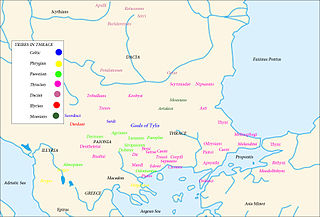 W
WCé was a Pictish territory recorded during the Early Medieval period and located in the area of modern-day Aberdeenshire, Scotland.
 W
WThe Kingdom of East Breifne or Breifne O'Reilly was an historic kingdom of Ireland roughly corresponding to County Cavan that existed from 1256 to 1607. It took its present boundaries in 1579 when East Breifne was renamed Cavan, after Cavan town, and shired into Ulster. Originally part of the older Kingdom of Breifne, East Breifne came into existence following a protracted war between the ruling O'Rourke clan and the ascendant O'Reillys which culminated in the division of the kingdom in 1256. The Kingdom was ruled by the dynasty of the Ó Raghallaigh (O'Reilly) and lasted until the early 17th century.
 W
WFortriu is the name given by historians to a Pictish kingdom recorded between the 4th and 10th centuries, and often used synonymously with Pictland in general. While traditionally located in and around Strathearn in central Scotland, it is more likely to have been located in and around Moray and Easter Ross in the north.
 W
WCait or Cat was a legendary Pictish kingdom originating c. AD 800 during the Early Middle Ages. It was centered in what is now Caithness in northern Scotland. It was, according to Pictish legend, founded by Caitt, one of the seven sons of the ancestor figure Cruithne. The territory of Cait covered not only modern Caithness, but also southeast Sutherland.
 W
WNoricum is the Latin name for the Celtic kingdom or federation of tribes that included most of modern Austria and part of Slovenia. In the first century AD, it became a province of the Roman Empire. Its borders were the Danube to the north, Raetia and Vindelicia to the west, Pannonia to the east and southeast, and Italia to the south. The kingdom was founded around 400 BC, and had its capital at the royal residence at Virunum on the Magdalensberg.
 W
WThe Regni, Regini, or Regnenses were a civitas of Roman Britain. Their capital was Noviomagus Reginorum, at the center of Chichester in modern West Sussex.
 W
WKingdom of Noricum, or Kingdom of Noric, ) is the Latin name for the Celtic kingdom or federation of tribes that included most of modern Austria and part of Slovenia.
 W
WThe Roman client kingdoms in Britain were native tribes which chose to align themselves with the Roman Empire because they saw it as the best option for self-preservation or for protection from other hostile tribes. Alternatively, the Romans created some client kingdoms when they felt influence without direct rule was desirable. Client kingdoms were ruled by client kings. In Latin these kings were referred to as rex sociusque et amicus, which translates to "king and ally and friend." The type of relationships between client kingdoms and Rome was reliant on the individual circumstances in each kingdom.
 W
WTylis or Tyle was a capital of a short-lived Balkan state mentioned by Polybius that was founded by Celts led by Comontorius in the 3rd century BC. Following their invasion of Thrace and Greece in 279 BC, the Gauls were defeated by the Macedonian king Antigonus II Gonatas in the Battle of Lysimachia in 277 BC, after which they turned inland to Thrace and founded their kingdom at Tylis. It was located near the eastern edge of the Haemus (Balkan) Mountains in what is now western Bulgaria. Some bands of Celts, namely the Tectosages, Tolistobogii and Trocmi, did not settle in Thrace, but crossed into Asia Minor to become known as the Galatians. The last king of Tylis was Cavarus who maintained good relations with the city of Byzantium. His capital was destroyed by the Thracians in 212 BC and this was also the end of his kingdom. The modern Bulgarian village of Tulovo in Stara Zagora Province now occupies the site.
 W
WThe Uí Liatháin (IPA:[ˈiːˈlʲiəhaːnʲ]) were an early kingdom of Munster in southern Ireland. They belonged the same kindred as the Uí Fidgenti, and the two are considered together in the earliest sources, for example The Expulsion of the Déisi (incidentally). The two have been given various origins among both the early or proto-Eóganachta and among the Érainn or Dáirine by different scholars working in a number of traditions, with no agreement ever reached or appearing reachable. It is entirely possible that they were the product of a combination of lineages from both these royal kindreds, or alternatively of another origin entirely.